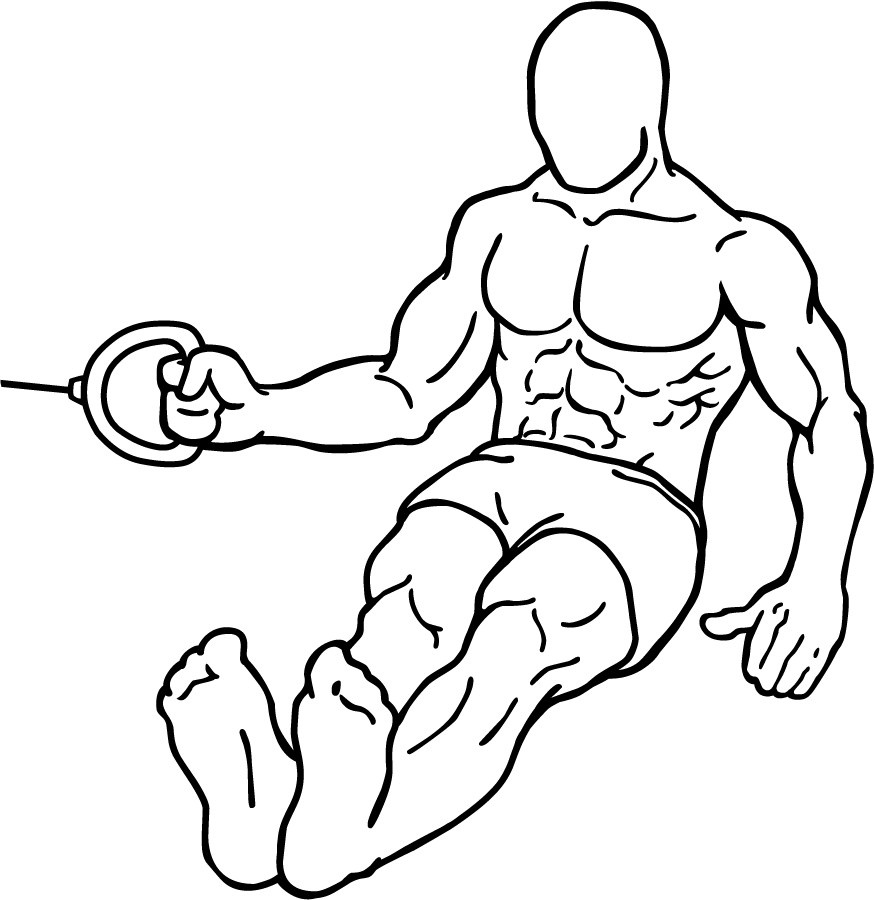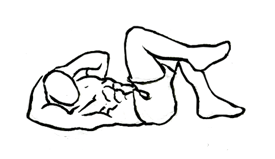Last Updated on September 25, 2014
The internal cable rotation is an essential exercise targeting the shoulder and biceps, crucial for building strength, stability, and overall functionality. This exercise is particularly valuable for individuals aiming to improve shoulder mobility and strengthen their biceps simultaneously. In this guide, we’ll dive into the technique, benefits, variations, and common mistakes to avoid when performing the internal cable rotation.
What is Internal Cable Rotation?
The internal cable rotation focuses on the rotator cuff muscles, specifically the subscapularis, and engages the biceps for stabilization. This movement helps enhance shoulder internal rotation, which is essential for daily activities like lifting objects, reaching across the body, or even during sports that require shoulder stability. Whether you’re a fitness enthusiast, athlete, or someone recovering from a shoulder injury, the internal cable rotation is a versatile exercise to add to your workout routine.
Muscles Worked
The internal cable rotation primarily targets:
- Rotator Cuff Muscles: Specifically, the subscapularis muscle. It helps internally rotate the shoulder and provides stability.
- Deltoids: Assisting in the movement and stability of the shoulder joint.
- Biceps Brachii: Engaged as a secondary muscle to stabilize the arm during the movement.
How to Perform the Internal Cable Rotation: Step-by-Step Guide
Before diving into the exercise, set up the cable pulley at a low position. Choose a light weight that allows you to perform the movement with control and precision. Follow these steps:
- Set Up: Sit on the floor close to the low cable pulley. Ensure that your body is positioned sideways, with your left side facing the cable machine.
- Grasp the Pulley: Hold the pulley handle with your left hand. Your arm should be bent at a 90-degree angle, with your elbow resting comfortably close to your torso.
- Starting Position: Position your elbow so it’s aligned with your side, and your forearm is pointing forward. Your wrist should remain neutral.
- Execute the Movement:
- Pull the cable slowly towards your body, internally rotating your shoulder.
- Rotate until your forearm is across your abs while maintaining a 90-degree bend at the elbow.
- Return to Starting Position: Gradually release the tension, returning your forearm to the starting position. Avoid letting the weight pull your arm back too quickly; control the movement.
- Repeat on the Other Side: After completing the desired repetitions with your left arm, switch to your right arm and repeat the steps.
Tips for Proper Form
To maximize the effectiveness and minimize the risk of injury, consider these essential tips:
- Maintain a Neutral Spine: Keep your back straight and your core engaged throughout the movement. This stabilizes your torso and prevents unwanted motion.
- Focus on Controlled Movements: Avoid rushing through the exercise. Slow, controlled rotations are more effective for building strength and reducing the risk of injury.
- Align Your Elbow Properly: Ensure your elbow remains close to your torso at all times. This provides support and isolates the shoulder muscles.
- Breathe Steadily: Inhale as you prepare for the movement and exhale as you pull the cable towards your body.
Benefits of Internal Cable Rotation
- Improves Shoulder Stability: Strengthening the rotator cuff muscles ensures that the shoulder joint remains stable during various movements, reducing the risk of injuries, especially for athletes involved in throwing sports or weightlifting.
- Enhances Biceps Strength: Engaging the biceps as a stabilizer helps to strengthen and define this muscle over time.
- Increases Shoulder Mobility: The rotational movement improves flexibility, making everyday tasks and athletic activities easier.
- Prevents Injuries: Regularly performing internal cable rotations can prevent common shoulder injuries, especially those related to rotator cuff strain or impingement.
- Rehabilitation-Friendly: This exercise is often recommended for those recovering from shoulder injuries or surgeries, as it helps rebuild strength and mobility safely when performed correctly.
Variations of Internal Cable Rotation
Adding variety to your workout routine can keep it engaging and target different aspects of the shoulder muscles. Here are some variations to consider:
1. Standing Internal Cable Rotation
This variation is similar but performed while standing instead of sitting. It engages the core and legs for stability, making it more of a full-body exercise.
- How to Perform: Stand sideways to the cable machine, holding the pulley handle with your closest hand. Keep your elbow bent at 90 degrees and close to your torso. Rotate the shoulder inward, pulling the handle across your body. Return to the starting position slowly.
2. Resistance Band Internal Rotation
If you don’t have access to a cable machine, a resistance band can be a great substitute.
- How to Perform: Anchor a resistance band at elbow height. Stand sideways with your working arm closest to the anchor. Pull the band across your body, rotating your shoulder inward. This variation is portable and can be done anywhere, making it perfect for home workouts or while traveling.
3. Incline Bench Internal Cable Rotation
For a more advanced challenge, perform the exercise on an incline bench to alter the angle of resistance and increase shoulder muscle activation.
- How to Perform: Position yourself on an incline bench with the low pulley handle. Ensure your elbow remains aligned with your side as you perform the rotation. This setup increases the difficulty by targeting stabilizing muscles further.
Common Mistakes to Avoid
Even a seemingly simple movement like internal cable rotation can lead to improper form if not performed correctly. Here are some mistakes to watch out for:
- Using Too Much Weight: This is a precision exercise, not a heavy lift. Using too much weight can cause your shoulder to compensate, leading to strain or injury. Start with light resistance and gradually increase as your strength improves.
- Arching the Back: Avoid arching your back during the movement. This usually happens when the weight is too heavy or when form is compromised. Engage your core to stabilize your spine and maintain a neutral position.
- Flared Elbows: If your elbow moves away from your torso, the emphasis shifts away from the targeted muscles, reducing the effectiveness of the exercise. Keep the elbow tight against your body to maintain the correct form.
- Rushing Through the Movement: This is a controlled exercise. Performing it too quickly diminishes its benefits and can increase the risk of injury. Focus on slow, deliberate movements.
Programming Internal Cable Rotations into Your Workout
Integrating internal cable rotations into your training routine can be beneficial for strength and injury prevention. Here’s how you can include it:
- Warm-Up Routine: Incorporate the exercise at the beginning of your workout as part of a warm-up to activate the rotator cuff muscles.
- Rehabilitation Protocol: If you’re recovering from a shoulder injury, include 2-3 sets of 10-15 reps with very light resistance, focusing on perfect form.
- Strengthening Program: For athletes or weightlifters, perform the internal cable rotation at the end of your workout with 3-4 sets of 12-15 reps to build endurance and maintain shoulder health.
FAQs About Internal Cable Rotation
Q1: Can I perform this exercise with free weights?
The internal cable rotation specifically benefits from constant tension provided by cables or bands, which is hard to replicate with free weights like dumbbells. However, resistance bands are an excellent alternative.
Q2: Is internal cable rotation suitable for beginners?
Yes, it is beginner-friendly when performed with light resistance. It’s a foundational exercise that helps build shoulder stability, making it a great addition for those new to strength training.
Q3: How often should I perform internal cable rotations?
For optimal results, perform the exercise 2-3 times a week as part of your shoulder or upper body workout routine. Consistency is key to seeing improvements in strength and mobility.
Q4: Can internal cable rotations help with shoulder pain?
While this exercise can strengthen the shoulder and potentially reduce pain related to weak rotator cuff muscles, it’s essential to consult a medical professional before starting any exercise if you have persistent or severe shoulder pain.
The internal cable rotation is a highly effective exercise for strengthening and stabilizing the shoulder muscles, particularly the rotator cuff and biceps. By following proper form, avoiding common mistakes, and gradually progressing in resistance, you can maximize its benefits. Whether you’re an athlete, bodybuilder, or someone looking to improve shoulder mobility and strength, incorporating internal cable rotations into your routine is a step towards a stronger, healthier upper body.








